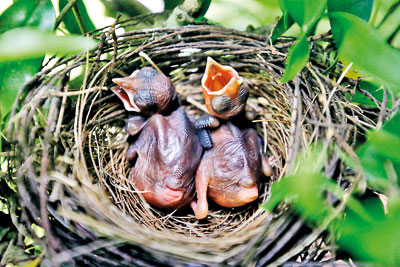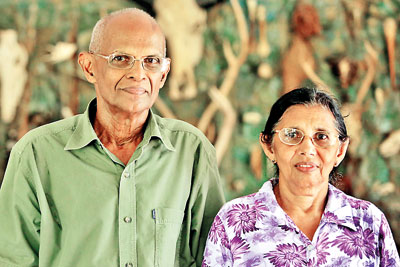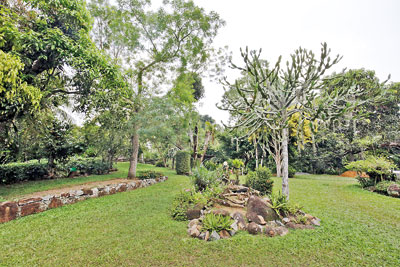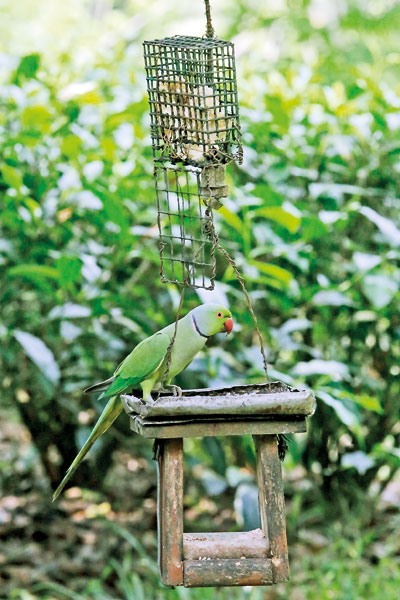Galle’s wonderland that is ‘Serengeti’

The hungry Red-vented bulbul babies
Sitting atop Galgamu-kanda, accessed by a winding, steep pathway is ‘Serengeti’ in Walahanduwa, with a view of the sea off Galle in the hazy and sunny distance.
‘Serengeti’ surrounded by lush greenery, large trees giving a wide canopy, smaller trees, plants, bushes and undergrowth is the home of Sarath and Premila Seneviratne.
Nay, it is not just the home of this retired couple, but also of bees, butterflies, birds and various small mammals.
It is a veritable birds’ paradise as we sit on the verandah sipping a delicious home-made drink from fruit picked from the garden with kasa-kasa temptingly at the top before a sumptuous luncheon, with a spread of vegetables also from the garden.
Suddenly, we hear the hungry chirping of baby birds and Sarath, with finger to lips, gently moves the branches of a kiri nuga bush near my chair to reveal a nest of the Red-vented bulbul with two nestlings in it.
A retired banker who has worked in remote areas, Sarath developed a passion for nature when his mother gifted him his very first book on birds when he was about seven years old and studying at St. Aloysius College, Galle. Their family home was at Hikkaduwa and he would keep cotton for birds such as bulbuls to take and make their nests. He would use the wall of his home as a marking-board to detail when eggs nestled within and when they would bring forth the babies. Later, as the family grew, he would keep a small bench to gain height to see the parent-birds feeding their young.
Being from a family of nine, Sarath who was the fifth boy says that there was no money for lavish spending and it was the pocket money for tiffin that he saved, when living with his Punchi Amma as it was closer to school. He would also ramble up the ramparts in search of birds, while scanning the newspapers to check out any books that were being published. Then he would make a beeline to the Universal Book Store in Galle to order them.
These precious acquisitions and much more including valuable collector’s items in the form of First Editions (all books of W.W.A. Phillips, G.M. Henry etc) tightly-line a large cupboard in his home. Details about the authors, including yellowed and frayed news-clippings and any letters Sarath had written to them along with the replies have been tenderly pasted on the books. This is while numerous photographs of birds are up on the walls.

Nature lovers: Sarath and Premila
The ‘wild’ trait had seen rapid progression, with Sarath joining the Wildlife and Nature Protection Society (WNPS) way back in 1961 as a schoolboy, being one of its oldest members recognized in 2012 as having an unbroken membership of 50 long years. Soon a request from well-known conservationist Thilo Hoffman — who has been credited with being the saviour of Sinharaja against its rape – had followed to join the Bird Club which he did most willingly in 1975.
Sarath had also palled up with well-known author T.S.U de Zilwa and in an era when digital photography was still unheard of, to enable the ‘capture’ of bird-images in their different forms of nesting, feeding et al, would provide photography hides for him. (Such ‘hides’ are purpose-made constructions for a photographer to get closer to a bird than would be normally possible if he was in full view.)
“We would take-off on such missions over the weekend, build high scaffoldings and use the ‘hides’,” laughs Sarath going down memory lane to Kumana, Bundala and other locations where birds were aplenty.
These numerous images so captured adorn T.S.U’s lovely books.
Before we go on a tour of the nature wonderland that is ‘Serengeti’, Premila, goes back to those early days. They had fallen in love with the land but there was no water or electricity. Their very first action in the early ’70s was to construct a small tank for rain-water harvesting and then sit and think how they would lug the building materials needed for their home up the hill.
It was Premila who moved into their partially-built home with their eldest son, 10-month-old Hemantha. Two more sons enriched their family, Sampath (who incidentally has taken up molecular ecology and evolution as a Research Scientist & Senior Lecturer in Zoology at the University of Colombo) born in 1977 and Leelanga in 1980.
Gradually, Sarath and Premila turned this patch of land into an exotic beauty-spot — like its namesake National Park in Tanzania — where if there is a slight delay, the birds in the wild clamour for their food and recognize their small car, a Viva Elite, as it climbs the last stretch home, giving them a guard-of-honour.
By 1984, Sarath was also very much a part of the team taking the bird census which he continued even in challenging times such as the youth insurrection of 1988-89. Husband and wife would take the essentials including the telescope tied to the motorcycle and a bare minimum of a bottle of water, while their three sons were in school, and follow the trail of birds, once even passing the body of someone who had been killed in the unrest.

A serene scene -- balm for the weary soul
As a gentle breeze moves the foliage this way and that and common mynahs, Rose-ringed parakeets, sunbirds, White-backed munias, Black-hooded orioles and even the rare Yellow-naped green woodpecker fly around, butterflies flit from bush-to-bush, squirrels scurry hither and thither and a thalagoya (iguana) seems to show the way, we walkabout untroubled by the afternoon heat.
From the verandah, our first stop is the ‘amphibian cave’, the hollow of a tree; then passing creepers, bushes, plants and trees such as veni-val, kiri-nuga, magul karanda, an-kenda, uguressa, delum, atteria, all kinds of lime trees, we come upon the ‘bat hollow’ set up for insect-eating bats, and jump over a stile to take a look at the ‘vegetable patch’ of wetakolu (ribbed gourd), maalu-miris (capsicum), wattakka (pumpkin), karawila (bitter-gourd), iringu (corn), rabu (radish), nivithi (spinach) lovingly tended by Premila and then tea-lands and more. The rainwater harvesting tank is still intact but bigger.
Both Sarath and Premila are justifiably proud of the exotic orchids including the Vesak orchid (Dendrobium maccarthiae) and Vanda tessellata they have nurtured.
It is after a long and relaxing afternoon watching myriads of birds at ‘Serengeti’ that we bid goodbye to Sarath and Premila, in total agreement with Sarath that watching birds is a “bavanawa” (meditation) in itself.

A morsel for a Rose-ringed parakeet. Pix by M.A. Pushpa Kumara


